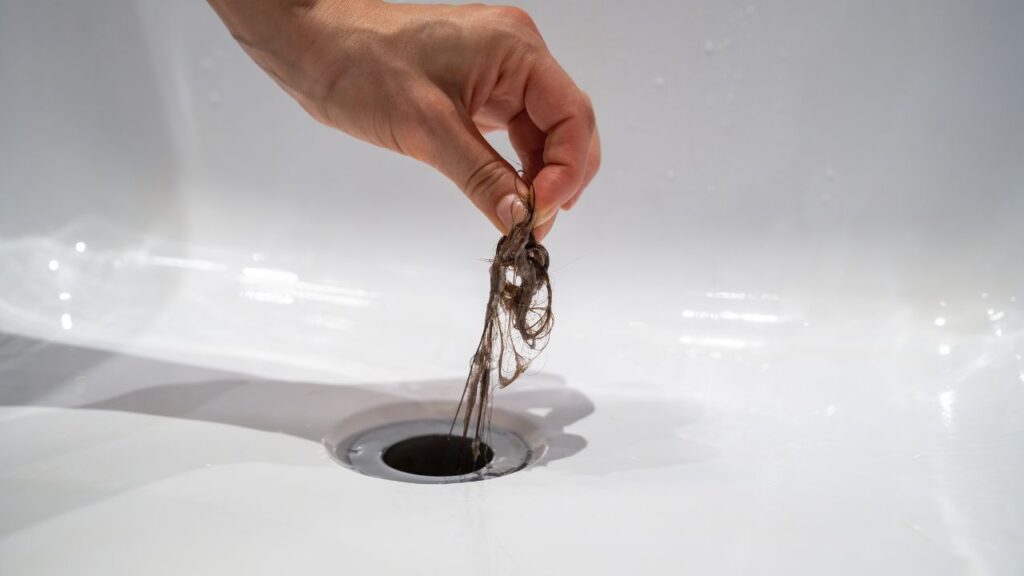Imagine a scenario where you’re in a hurry, but your bathroom sink refuses to drain. One of the most common culprits is hair—a silent blocker that gradually builds up over time, causing water to pool in your sink. If you’ve found yourself in this situation, don’t worry! You’re not alone, and there are simple solutions to this problem.
It’s important to understand that hair, along with other materials like soap scum, can form a nasty clog in your bathroom sink. But, with the right tools and a bit of patience, you can easily unclog your sink and restore its normal function. Today, we’re going to discuss some common causes of bathroom sink clogs and the tools you’ll need to tackle the problem head-on.
Common Causes Of Bathroom Sink Clogs
While hair is often the main offender, bathroom sinks can get clogged due to a variety of reasons. Let’s discuss the common ones:

Hair: Hair is the number one cause of bathroom sink clogs, especially in households with long-haired individuals. Hair can easily get tangled and caught in the drain, causing a blockage that is difficult to remove.
Soap Scum: Soap, when mixed with hard water, forms soap scum—a hard residue that can build up and block your sink over time.
Dirt and Grime: Dirt and grime, if not regularly cleaned, can accumulate in your sink drain, leading to blockages.
Small Objects: Small objects like jewelry, bottle caps, or toothpaste caps can accidentally fall into the sink and can cause a clog if they’re not immediately retrieved.
Tools & Materials Needed For Unclogging
With a variety of tools and materials at your disposal, unclogging a bathroom sink is a task you can handle on your own. Here are the essential tools you’ll need:
Zip-It or Drain Cleaning Tool: This is a thin, flexible tool with a barbed edge, perfect for grabbing and pulling out hair and other debris from your sink drain.
Plunger: A common household item that can be used to dislodge clogs. Ensure you use a flat “”cup”” plunger for sinks, not a flange plunger, which is designed for toilets.
Baking Soda and Vinegar: These common kitchen ingredients form a fizzy mixture that can help dissolve minor clogs and clean your drain.
Adjustable Wrench: This tool is essential if you need to remove the P-trap—the U-shaped pipe beneath your sink.
Now that we know what causes bathroom sink clogs and the tools we need to fix them, let’s get into the nitty-gritty of how to actually unclog a bathroom sink. Stay tuned!
Method 1: Using AZip-It or Drain Cleaning Tool
One of the most effective ways to unclog a bathroom sink, especially when dealing with hair, is by using a Zip-It or drain cleaning tool. These tools are designed specifically to latch onto hair and other debris, allowing you to pull the clog out directly.
Here’s how to use it: Insert the barbed end of the tool into your sink drain, pushing it as far as it can go. Once it’s in, gently move it back and forth. This motion helps the tool’s teeth grab onto the hair and debris. After you’ve done this for a moment, slowly pull the tool out. You’ll likely be surprised at how much hair it’s able to retrieve!
Method 2: Baking Soda & Vinegar Solution
Another popular and effective method for unclogging bathroom sinks involves using household items you likely have on hand: baking soda and vinegar. This dynamic duo creates a fizzy reaction that can break down minor clogs and clean your drain.
To use this method, begin by pouring a small amount of dish soap into the drain. Follow this with a cup of baking soda and a cup of vinegar. These ingredients will react and create a fizzing action that helps to dissolve grime and push through smaller clogs. Let this mixture sit in your drain for at least five minutes, although some may recommend leaving it for up to an hour for tougher clogs. Once the time is up, flush the drain with boiling water to help wash away the remaining debris.
If the clog hasn’t completely disappeared, you can use a flat “”cup”” plunger to further dislodge the blockage. Remember, the aim is to create a strong enough force to move the clog, so be prepared to exert some effort!
Method 3: Physical Removal – Cleaning the Drain Trap & Stopper
If the above methods haven’t fully cleared the clog, it might be time to roll up your sleeves and physically remove the blockage. Don’t worry, you don’t need to be a professional plumber to do this.
Start by removing the sink stopper. This can usually be done by unscrewing the pivot rod nut located under the sink and pulling the stopper out from above. Once it’s out, check it for hair and gunk, and clean it off.
If the clog is still there, you may need to clean the drain trap, also known as the P-trap. This is the U-shaped pipe beneath your sink. Unscrew the trap and inspect it for blockages. If you find any, clear them out, then reassemble the trap and check for leaks.
While these methods may seem a bit hands-on, they’re actually quite straightforward and can be incredibly effective at removing stubborn clogs in your bathroom sink.
Alternative DIY Methods For Unclogging
If you’ve tried the Zip-It tool, baking soda and vinegar method, and physically removing the clog but your sink is still draining slowly, don’t worry. There are other DIY methods you can use to unclog your bathroom sink. Here are a couple:
Wire Hanger: You can make a simple yet effective drain cleaning tool with an old wire hanger. Straighten the hanger, then create a small hook at one end. This can be used to fish out hair and other debris from your drain.
Drain Snake: If you’re dealing with a particularly stubborn clog, a drain snake could be your best bet. This tool works by breaking up and removing the clog deep within your pipes.
Baking Soda and Salt: Another alternative solution involves a mixture of baking soda and salt. Simply pour half a cup of each into the drain, let it sit for 15 minutes, then flush with boiling water. This can help disintegrate tough hair blockages.
Preventive Measures To Avoid Future Clogs
While it’s important to know how to unclog a sink, it’s even more beneficial to prevent clogs from happening in the first place. Here are some preventive measures you can take:
Regular Cleaning: Regularly clean your sink and drain to prevent the buildup of hair, soap scum, and other debris.
Drain Covers: Use a drain cover or strainer to catch hair and other materials before they go down the drain.
Avoid Dumping Certain Substances: Avoid dumping substances like coffee grounds, grease, and cooking oil down your sink, as they can cause clogs.
When To Call A Professional Plumber?
If you’ve tried all the DIY methods and your sink is still clogged, it might be time to call a professional plumber. Persistent clogs could be a sign of a bigger problem, such as a blockage in your main sewer line. A professional plumber has the tools and expertise to diagnose and fix such issues.
Remember, while it might cost more to hire a professional, it could save you a lot of time and frustration in the long run. Plus, you’ll have the peace of mind knowing your plumbing issue has been properly addressed.
In conclusion, unclogging a bathroom sink clogged with hair can be a messy and frustrating task, but with the right tools and techniques, it’s definitely doable. And with a bit of preventive maintenance, you can keep your sink draining smoothly for a long time to come.





